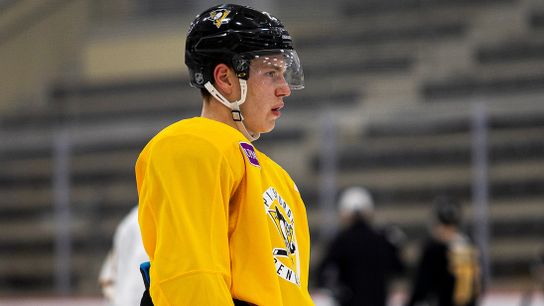The Penguins drafted two prospects out of the QMJHL -- forwards Samuel Poulin and Nathan Legare -- in this year's draft. They have one other prospect still playing major junior hockey in Canada, with defenseman Calen Addison in the WHL.
The Canadian Hockey League, or CHL, is the organization that oversees the QMJHL, WHL and OHL junior leagues. What can the CHL's transfer agreement with the NHL tell us about the paths those players will take?
WHAT IS THE CHL-NHL TRANSFER AGREEMENT?
For an NHL draft prospect to leave the QMJHL, WHL or OHL to play minor-league hockey, he must be 20 years old (by Dec. 31 of that season) or have played four seasons in juniors.
Junior players can still leave their junior team beginning at age 18 to play in the NHL. The agreement only prevents players from leaving early to play minor-league hockey. If a player is not going to be playing in the NHL, he must be sent back to his junior team.
Juniors-eligible players may still play up to nine games in the NHL at the beginning of a season as a trial. After nine games, the NHL team can return the player to juniors with no effect on his contract. If a player is kept beyond nine games, his entry-level contract kicks in. If an NHL team keeps a player beyond nine games and later decides to return him to juniors, it can do so, but that still burns his entry-level contract. If a player is returned to juniors, he can't return to the NHL team until his junior team's season ends.
Example: In the fall of 2015, there was a debate whether 18-year-old Daniel Sprong should crack the Penguins’ NHL roster, or be sent back to the QMJHL. Once he played his 10th game in the NHL, his entry-level contract kicked in. After 18 NHL games, the Sprong experiment ended, and he was sent back to his junior team. Even though he spent the bulk of the 2015-16 season in juniors, and the entire 2016-17 season in juniors, he was burning through the first year of his entry-level contract because he played more than nine NHL games in 2015.
There are exceptions to the rule. A player must be drafted by or signed by an NHL team for the transfer agreement to apply to them, since the agreement is between the CHL and NHL.
Example: Forward Renars Krastenbergs played for the Nailers on an AHL-level contract last season despite being 19. He had previously played two seasons in the OHL but was never drafted by an NHL team, so he was allowed to leave the OHL before he turned 20. The NHL's transfer agreement didn't apply to him because he isn't property of any NHL team.
Another exception is if an NHL club drafts a player out of a European league, and then the player joins one of the CHL leagues after the NHL draft. Since he was property of an NHL team before he joined the CHL, he isn't bound to the transfer agreement. This is a rare occurrence though, as most players drafted out of European leagues continue to develop in the European league before moving to North America.
WHAT ABOUT OTHER PROSPECTS?
Only juniors-eligible players who were drafted by an NHL team must wait until they're 20 to play in the minors.
The minimum age for the AHL and ECHL is 18 (by Sept. 15 of that season). If a player is leaving Europe or college before age 20, or the player is in juniors and was undrafted, he can still play in the minors as long as he's 18.
However, the NHL does have transfer agreements with the governing bodies of hockey programs in most other countries. If an NHL team wishes to bring a prospect from say, Finland, over to North America and he is still under contract with his Finnish club, the NHL pays a fee to the Finnish Ice Hockey Association and the contract can be broken.
The NHL does not have a transfer agreement with the Ice Hockey Federation of Russia, so the NHL can't pay to break the contracts of KHL players. They must honor them.
WHAT ABOUT WHEN JUNIOR SEASONS END?
Players who are restricted from playing in the minors during the season are allowed to play in the minors on an amateur contract after their junior team's season ends. The same rules still apply to the player the following season.
Example: Jan Drozg played for Wilkes-Barre/Scranton in each of the past two seasons after his QMJHL team's season ended.
WHY DOES THE AGREEMENT EXIST?
At first, it may seem like the agreement holds back some of the top junior prospects, but that isn't exactly the case.
The CHL is such a good developmental system because of the top players playing in those leagues. They keep those leagues competitive. If all of the high-end players moved on to the AHL at at age 18, then the level of talent in the three leagues would be diminished, and the leagues wouldn't be able to produce the talent they do.
Having high-profile players remain in the CHL is also beneficial financially when it comes to marketing the leagues.

